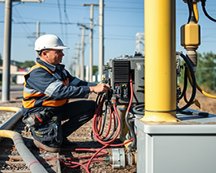Published: October 29, 2014 | Updated: September 16, 2025
Published: October 29, 2014 | Updated: September 16, 2025
Unraveling the Truth: Maintenance Management Misconceptions
Many misconceptions abound in the real of facility and maintenance management, These myths, often spread through casual conversation or fleeting internet posts, can lead to inefficiencies and misdirected strategies. This article unravels the truth concerning 3 maintenance management misconceptions. We'll also explore how a computerized maintenance management system (CMMS) plays a role in clearing the fog.
 Myth 1: CMMS Software is Solely for Preventative Maintenance
Myth 1: CMMS Software is Solely for Preventative Maintenance
One can understand the notion that a CMMS only organizes preventative maintenance. Yes, helping preventive maintenance and handling work orders lies at the core of the system. However, many believe the limitations go no further than scheduling and tracking routine tasks.
This perspective, however, significantly undervalues the capabilities of a modern CMMS. Many employees in a company can use a CMMS for more than just maintenance.
- Asset Management – Tracking performance and reliability issues using various reports such as key performance indicators.
- Inventory Control – Organize your stockroom with a location for every part and supply. Set up an issue/return policy through the CMMS. Have it generate specific count sheets for the regular physical count.
- Purchasing – The same system used for maintenance can process purchase requests and purchase orders. List your vendor information and formalize purchase order forms. It will also process receiving and invoicing.
- Human Resources – Setup holidays and process employee timecards.
- Work order Management – Create, schedule, dispatch, and track work requests and work orders through the CMMS.
- Reports – From costs of assets, inventory, and labor, to top equipment failures to location of inventory to backlogged work orders and so much more. A quality system will provide plenty of filters and parameters to hone the information to what you need.
- Documentation – Bring up reports and other documentation for auditors and regulators to stay in compliance.
How a CMMS Debunks This Myth
A CMMS reveals its true potential by providing a holistic view of maintenance operations. It consolidates data from various sources, offering insights that go beyond simple preventative schedules. By tracking work orders, asset performance, and inventory levels, a CMMS demonstrates its ability to handle a wide array of maintenance tasks. It proves that it is a central hub for all maintenance-related data and activities. It allows for the easy generation of reports that show the total maintenance picture. This dispels the narrow perception of a CMMS as a single-purpose tool.
It also shows its reach by integrating with other systems such as enterprise resource planning and accounting. Yes, you'll need assistance from the CMMS provider, but once you have this established, other departments have access to the system's information.
 Myth 2: Maintenance Management Primarily Cuts Costs
Myth 2: Maintenance Management Primarily Cuts Costs
While cost control comes from effective maintenance management, framing it solely as a cost-cutting measure limits its perspective. True maintenance management drives revenue and enhances overall profitability. By focusing on asset reliability and uptime, organizations can minimize disruptions and maximize production capacity. This leads to increased output and, consequently, higher revenue.
Furthermore, a well-maintained facility reduces the risk of accidents and injuries, which can lead to costly legal and medical expenses. Efficient energy management, another aspect of maintenance, contributes to lower operating costs and a smaller environmental footprint.
Additionally, proactive maintenance strategies can extend the lifespan of assets, reducing the need for premature replacements and capital expenditures. A well-managed facility can also increase employee productivity, as employees are not hampered by equipment failure and unsafe working conditions.
How a CMMS Debunks This Myth
A CMMS provides the data to demonstrate the revenue-generating potential of effective maintenance. By tracking asset performance and uptime, organizations can identify areas for improvement and implement strategies to enhance productivity.
The reporting capabilities of a CMMS allow for detailed analysis of maintenance costs and their impact on revenue. It shows that maintaining assets as a strategic investment, not just an expense. The data shows the true cost of downtime and the benefits of proactive maintenance. A CMMS provides the hard data to show the true value of a strong maintenance program.
Discover how streamlined maintenance processes can elevate production. Learn more.
 Myth 3: Preventative and Reactive Maintenance Suffice
Myth 3: Preventative and Reactive Maintenance Suffice
While these have importance in their own manner, you must go deeper. Sometimes, they often fail to address the root causes of equipment failures. Proactive maintenance, on the other hand, focuses on predicting and preventing failures before they occur.
This involves using advanced technologies, such as sensor data and predictive analytics, to monitor asset performance and identify potential issues. By addressing these issues early, organizations can prevent costly downtime and extend the lifespan of their assets. Proactive maintenance also involves continuous improvement, where maintenance processes constantly evaluated and refined to enhance efficiency and effectiveness.
For instance, instead of merely lubricating a part, proactive maintenance might involve redesigning the part to eliminate the need for lubrication altogether. This approach leads to long-term reliability and reduced maintenance costs.
How a CMMS Debunks This Myth
A CMMS can play an important role in implementing proactive maintenance strategies. At one level, you can record and track equipment readings to help shape your preventive maintenance program. Some systems will integrate sensor data and other performance metrics and identify patterns and trends that indicate potential failures. It allows for the creation of predictive maintenance schedules, ensuring that maintenance is performed before failures occur.
Furthermore, a CMMS facilitates the documentation and sharing of best practices, promoting a culture of continuous improvement. By integrating with sensor data, and other tools, a CMMS allows for real-time monitoring of asset conditions and helps to predict failures before they happen.
In conclusion, maintenance management myths hamper efficiency and productivity. By understanding the true potential of a CMMS and embracing proactive maintenance strategies, organizations can enhance reliability, increase revenue, and achieve long-term success. Do not accept common myths as fact, use all available tools to ensure a strong maintenance program.
FAQs
What is the biggest misconception about CMMS software?
Many believe a CMMS only handles preventive maintenance, but modern systems like MAPCON CMMS manage assets, inventory, purchasing, compliance, and more.
Does maintenance management only focus on cutting costs?
No—effective maintenance management improves uptime, boosts productivity, and helps generate revenue by extending asset life and reducing downtime.
How does proactive maintenance differ from reactive and preventive maintenance?
Proactive maintenance uses data, analytics, and continuous improvement to address root causes of failures before they happen, improving reliability.
Can a CMMS like MAPCON improve compliance and reporting?
Yes, MAPCON CMMS stores critical documentation, tracks inspections, and generates detailed reports, making audits and compliance much easier.
How does maintenance management impact productivity?
Well-managed maintenance reduces disruptions, keeps equipment running at peak performance, and enables employees to focus on their work safely and efficiently.
How does a CMMS support proactive maintenance strategies?
A CMMS like MAPCON integrates with sensors, tracks equipment readings, and identifies failure patterns, helping implement predictive and proactive maintenance.
MAPCON | 800-922-4336
MAPCON CMMS software empowers you to plan and execute PM tasks flawlessly, thanks to its wealth of features and customizable options. Want to see it for yourself? Click the button below to get your FREE 30-day trial of MAPCON!
Try It FREE!